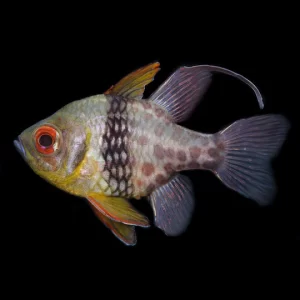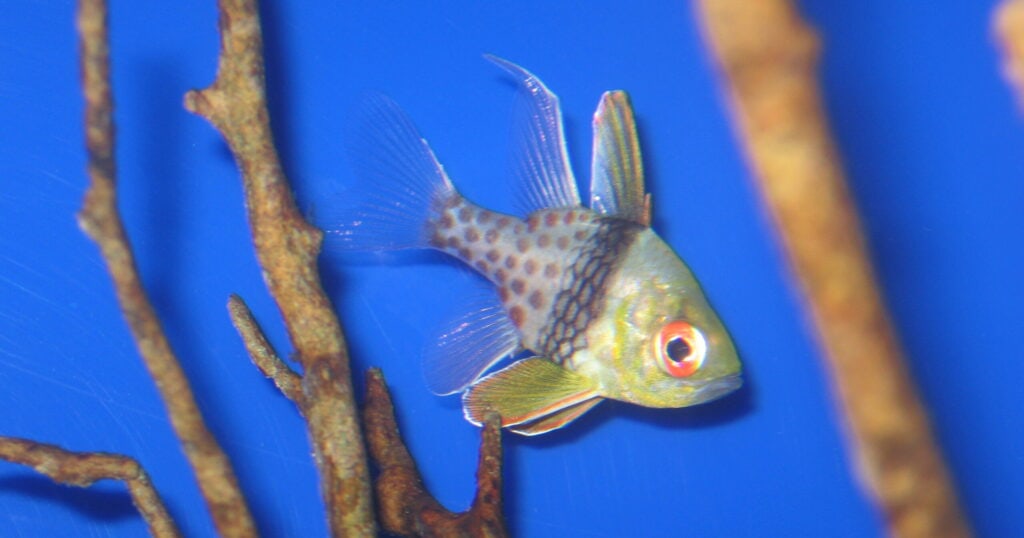The families of smaller reef fish aren’t only for nano tanks; particularly when kept in social groups, they can be just as interesting and showy as any of their larger counterparts. Cardinalfish (Family Apogonidae) are an excellent example of this. Among the most hardy and colorful of the cardinalfish is the pajama cardinalfish (Sphaeramia nematoptera). These attributes, as well as their availability as captive bred, make them highly desirable to any reef aquarist.
Pajama cardinalfish natural history
The pajama cardinalfish (also known as the spotted cardinalfish, coral cardinalfish or polkadot cardinalfish) is distributed throughout the tropical IndoPacific Ocean (Java, Papua New Guinea, the Philippines and Indonesia to Tonga and Fiji, and from the Ryukyu Islands to the Great Barrier Reef). It is primarily reef-associated, inhabiting depths ranging from 1 to 14 meters within sheltered bays and lagoons.
 It is known to form groups that collectively hide among colonies of branching Porites corals. Like most of their cardinalfish brethren, pajama cardinals are very active in the twilight hours; their small groups disperse at night, hunting just over the dark reef bottom.
It is known to form groups that collectively hide among colonies of branching Porites corals. Like most of their cardinalfish brethren, pajama cardinals are very active in the twilight hours; their small groups disperse at night, hunting just over the dark reef bottom.
It is a small fish (to around 3 inches length) with a relatively short lifespan (two to five years). The species is distinguished by its highly unusual–gaudy, even–colors and pattern. It has a silvery base color with a greenish-yellow face with large red eyes. A dark, broad, vertical waistband stripe runs down its midsection. Numerous red spots cover its posterior to the tail. The dots are black on young individuals but turn red as they mature.
While the species is difficult to sex, males are usually distinguished by a longer secondary dorsal fin than females. Females have slightly rounder bodies than males. Males incubate the eggs in the mouth until they hatch. The parents might exhibit more aggressive behavior during the courtship and spawning; initially, the male protect the female until brooding the eggs in his mouth, then the female protects the male from other fish during the brooding period. The male carries both eggs and fry in its mouth for 3 to 4 weeks. Males do not eat while brooding eggs.
Aquarium care
The pajama cardinalfish has for long been a popular aquarium species. It is an exceptionally hardy species and is quite simple to care for. As such, it is well suited for beginners.
The pajama cardinalfish is fairly peaceful as far as marine fish go, and therefore is appropriate for any ‘community’ marine aquarium. It technically is reef-safe though not necessarily ‘invertebrate-safe’ for the reason that it may eat vulnerable crustaceans such as very small shrimp.
An aquarium of at least 30 gallons volume is adequate for this species. However, a larger aquarium is highly recommended, as this allows for a small school of, say, a half dozen or so individuals. As with many small reef fish, the aquascape should incorporate many hiding places. Overhangs are particularly appreciated, as this fish spends much of its time during the daylight hours hiding in shady spots. In the wild, it has been observed hiding between the spines on sea urchins (something one might witness in the aquarium). Lower light levels are ideal.
The pajama cardinalfish is easy to feed as it accepts most foods, including flake food. It is important to give them a varied diet that contains all the nutrients they need. To this end you should feed them a varied diet containing frozen food, flake food and finely chopped seafood. The pajama cardinalfish appreciates an offering of live food every now and then. Feed this fish 2-3 times daily (ideally, just before and just after lights-out time).
The pajama cardinalfish will breed in aquariums and is relatively easy to rear. Once a pajama cardinalfish pair has started breading, they generally continue to do so often. The species is a mouth brooder; the male carries the eggs. Pajama cardinalfish fry are large and can eat newly hatched brine shrimp as soon as they are released. The fry are aggressive. More aggressive fry can drive more timid siblings away from the food. It is thus a good idea to separate the aggressive and non-aggressive fry into different aquariums for a higher survival rate. The fry are not as sensitive as many other marine fish fry and grow rapidly.
This species gets some mixed reviews when it comes to ease of feeding. Clearly, this fish isn’t very picky about the food itself; any small-bite meaty food (especially small crustaceans such as brine shrimp, mysis shrimp, larger cyclops, etc.) will do. Most often, fully adjusted individuals happily accept prepared foods (such as flakes and small pellets) as well. The reported difficulties probably arise from feedings that occur when the fish is most shy (in bright light) or in the presence of aggressive tankmates. The obvious solution here is to keep this species only with other mild-mannered species and to keep the light levels low (or alternatively feed in the evening). Additionally, captive bred specimens are already accustomed to aquarium life and will therefore be considerably easier to feed.
Conclusion
Given the hardiness and ease of care of tank bred pajama cardinalfish, it is a trouble-free fish for anyone including newbie hobbyists. With their amazing colors and pattern, they look great in any display. In fact, they are not just showy in a tiny tank; in a large system, a group can indeed create an exceptionally dramatic and eye-catching scene. All in all, it’s pretty hard not to love this fish!






Leave a Reply